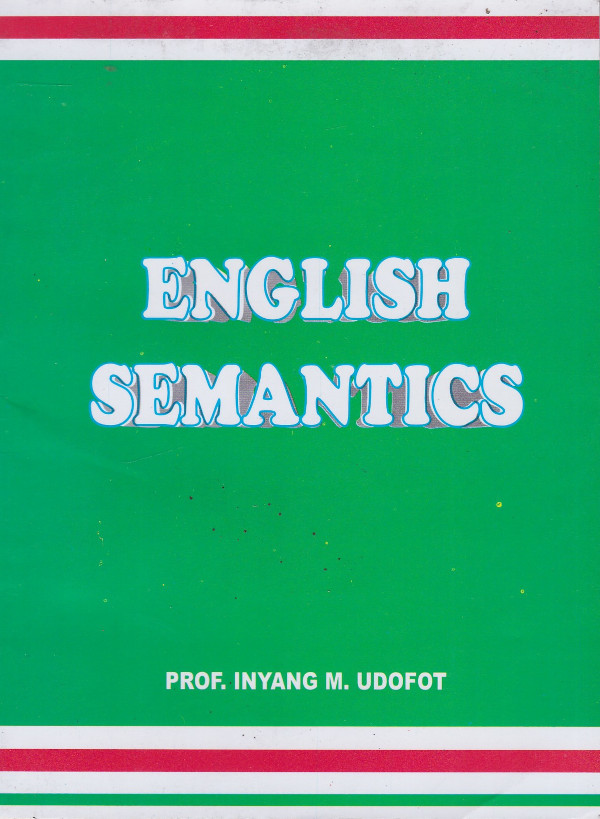English Semantics
$5.00
ABOUT THE BOOK
English Semantics introduces fundamental issues in semantics with a slant on the analysis as it affects the English Language. Occasionally, it elaborates on some oj the issues discussed. An attempt is made to examine the thoughts in semantic circles from the ancient through the medieval to the modern times with a conscious avoidance of some of the linguistic technicalities that would scare a beginner. The result is that English Semantics will be readily intelligible to a lay man as well as beginning students of Language andlinguistics. The advanced student will find the book an invaluable guide.
ISBN: 978-2275-29-8
PREFACE
Three students of my 1996/97 Semantics class of
the University of Uyo on three occasions individually
chatted with me after their end of semester examinations:
‘We really liked the lectures’, one of them said, ‘You know,
we used to dread the course but you have made it so
enjoyable. I hope most of us will do well in the
examination’. I told her that I hoped so too. Another one
told me he would have scored an A if he had books to
read other than his lecture notes. He complained that
most of the recommended texts were not available. He
did score an A in the course. The other similarly
expressed sentiments about the course in supcrlative
terms and ended up saying: ‘Madam, why don’t you write
a book on Semantics; it would demystify the course as
your lectures have done’. I told him ] would fine time to
do so during the long vacation.
When I finished marking, all the undergraduate
students who offered the course passed. So I started
writing this book encouraged by their performance. |
intended to produce an introductory text for
undergraduates of English, Linguistics and
Communication Arts who take courses in Semantics. In
the course of writing, I remembered my post-graduate
students of Advanced Semantics. So, I ended up
introducing most of the topics discussed here and
occasionally elaborating to cater for the interest of this
group too. When | finished, I felt I had not written all I
would have wanted to in some topics nor did I write b
enough on others.
I have ended up producing a book on Scmantics.
It is called English Semantics because most of the
examples used for discussion are from English. It can
however pass for a linguistic analysis of the topics under
discussion so the student of Linguistics and
Communication Arts would find it uscful. The general
reader too may find it a useful and interesting
introduction to the problem of meaning in Language.
I am thankful to my husband, Prof. Mbong Udofot
and my children for sparing me while I was writing this.
I thank also my colleagues and friends: Prof. David Eka
and Dr. Eno-Abasi Urua for reading over the manuscript
and making useful suggestions. My husband also read
over the manuscript and gave me financial support to
help its publications. Finally, 1 thank the typists Mrs.
Atim Okon for dutifully typing the manuscript and Miss
Inemesit Etuk, for the word processing.
Prof. Inyang M. Udofot
Department of English
University of Uyo, Uyo.
Description
TABLE OF CONTENTS
CHAPTER ONE: THE NATURE OF MEANING
1.1 The Status of Meaning
2 Language and Meaning
3 The Study of Meaning
4 The Meaning of Meaning
5 Change of Meaning
6 Causes of Semantic Change
7 Types of Semantic Change
CHAPTER TWO: SHADES OF MEANING
2.1 Denotative Meaning
2.2 Connotative Meaning
2.3 Sources of Emotive Overtones
2.4 Emotive Devices
2.5 Collocative Meaning
2.6 Idiometic Meaning
CHAPTER THREE: REFERENCE AND SENSE
3.1 The Notion of Reference
3.2 Implications of Reference
3.3. Sense and Sense Relations
3.4 Synonymy and Antonymy
3.5 Homonymy and Syntagmatic
3.6 Paradigmatic and Syntagmatic Relationships
3.7 Hyponymy
CHAPTER FOUR: EARLY THEORIES OF MEANING
4.1 Nominal Theories
4.2 Conceptual Theories
4.3 Evaluation of Conceptual Theories
4.4 Contextual Theorics
4.5 Context of Situation
4.6 Behaviourism
4.7 An Evaluation
CHAPTER FIVE: LATTER THEORIES OF MEANING
5.1 Componential Analysis
5.2 Notation
5.3 Evaluation of Gompacendal Analysis
5.5 Entailment
5.6 Presupposition
5.7 Implicatures
5.8 Speech Act Semantics
5.9 An Evaluation
CHAPTER SIX: MEANING AND SOCIETY
6.1 Linguistic Relativity
6.2 Language, Culture and Style
6.3 Deictics
6.4 Semantic Fields
6.5 Semantics Universals
6.6 Implications for Translation
CHAPTER SEVEN: ADVANCES IN THE STUDY OF MEANING
7.1 Pragnatics
7.2 Uttrance Interpretation
7.3 I-Semantics
7.4 The Nature of Truth and Reference
7.5 Compositionality and University of Semantic Vocabulary
7.6 The Nature of Conceptual Categories
7.7 Human Concepts and Natural Language Semantics
7.8 Reference in 1-Semantics
7.9 Concluding Remarks
REFERENCES
INDEX
Prof. (Mrs) Inyang Udofot
Prof. (Mrs) Inyang Udofot is a Professor of English Phonetics and Semantics in the Department of English, University of Uyo She is also the author of An Introduction to the Morphology of English, the Co-author of Aspects of Spoken Language, An Oral English Course jor Schools and Colleges and A Comprehensive English Course for Schools and Colleges. She has authored several articles in both national and international journals.
Visit www.inyangudofot.com.ng for information.
Questions and Answers
You are not logged in
